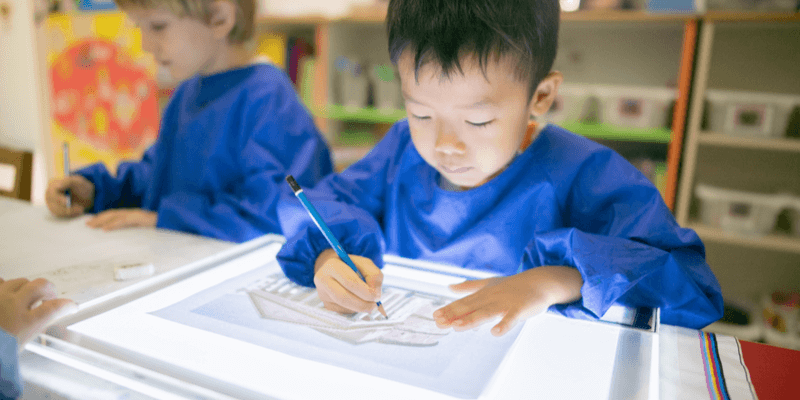Home >
Blog >
What is the recommended screen time for children?
What is the recommended screen time for children?

Nov 1, 2019 9:00:00 AM
Technology has become ubiquitous in our lives. It has shaped the way we communicate, work and consume. In the current age of knowledge economy, it is important for children to learn information and communications technology (ICT) in order to enhance their knowledge and skillset. However, it is crucial that this does not replace adequate sleep time and physical activity.
On 24th April, a panel of experts at the World Health Organisation (WHO) developed guidelines on physical activity, sedentary behaviour, sleep and screen time for children under 5 years of age. This blog will discuss the recommendations as well as how provide tips on how children can use technology and sedentary time effectively.
RECOMMENDATIONS FROM WHO
Guidelines on screen time
- Children aged less that 1: Screen time is not recommended.
- Children aged 1 – 2 years: For children aged 1, sedentary screen time (e.g. watching TV, playing computer games) is not recommended. For children aged 2 years, sedentary screen time should be no more than 1 hour; less is better.
- Children aged 2-5 years: Children in this range should have no more than one hour of sedentary screen time per day.
Guidelines on sedentary behaviour
WHO emphasised the importance of quality sedentary time spent in interactive non-screen-based activities such as reading, storytelling and puzzles. Additionally, less time spent retrained (e.g. in car seats, strollers, high chairs) has numerous benefits such as improved motor and cognitive development.
- Children aged less than 1: Should be physically active several times a day in a variety of ways, particularly through interactive floor-based play. Children who are not yet mobile should spend at least 30 minutes in proneposition spread throughout the day and should not be restrained for more than 1 hour at a time.
- Children aged 1 - 2 years: Should spend at least 180 minutes in a range of physical activities at any intensity spread throughout the day. They should not be restrained for more than 1 hour at a timeor sit for extended periods of time.
- Children aged 3 - 4 years: Should spend at least 180 minutes in a range of physicalactivities of which at least 60 minutes is moderate to vigorous intensity. Not to be restrained for more than 1 hour at a time or sit for extended periods of time. When sedentary, engaging in reading and storytelling with a parent or carer is encouraged.
Guidelines on sleep
Sleep is essential for the cognitive, physical and psychosocial development of children. According to the Sleep Research Society, lack of sleep is associated with obesity in infants as well as performance deficits such as lower school grades and mood and behavioural disruption.
- Children aged less than 1: Should have 14 – 17 hours (0–3 months of age) or 12 – 16 hours (4–11 months of age) of good quality sleep, including naps.
- Children aged 1 - 2 years: Should have 11 - 14 hours of good quality sleep, including naps, with regular sleep and wake-up times.
- Children aged 3 - 4 years: Should have 10 – 13 hours of good quality sleep, which may include a nap, with regular sleep and wake-up times.
THE IMPACT OF TOO MUCH SCREEN TIME
What are the physical and mental effects on children routinely using too much technology?
- Reduced sleep: When children spend long periods of time in front of a screen, they tend to sleep later at night which can result in losing out on a good night’s sleep.
- Weight control difficulties: There is link between long hours of sedentary activities and weight issues as children grow up.
- Difficulty socialising: Children learn social behaviour and develop emotional intelligence through play and interaction. When children spend more time on their screens instead of interacting with others in real life, they can find it difficult to connect with the real world.
- Delayed learning ability: An excessive amount of screen time can delay the rate at which toddlers engage in cognitive processing. Toddlers must utilise their five senses in order to learn about the world around – screen time only focuses on two senses (sight and sound). This limits their ability to focus and process information.
- An ongoing study from the National Institutes of Health testing how screen time affects children’s brains showed that children who have more than two hours of screen time a day achieved lower scores on tests focused on thinking and language skills.
- Impatience: When screen time is purely used as a distraction, it can result in children becoming over-stimulated, unable to cope with boredom and developing shorter attention spans. Boredom encourages imagination (as children find creative ways to entertain themselves).
- Eyesight problems: Excessive screen time can result in eye strain and poorer vision as children grow up such as myopia.
- Screen Dependency Disorder: Children may develop addictive behaviour towards technology and experience symptoms such as headaches, poor nutrition and self-isolation as well as lack of impulse control.
HOW TO USE SCREEN AND SEDENTARY TIME EFFECTIVELY
Some groups have argued that the recommendations set by the WHO have failed to consider the positive impact of digital media for children. Technology can be used for educational purposes. For instance, many apps can be used to teach children new languages, aid mathematics and offer interactive role-playing opportunities. Video games that involve solving puzzles aid the development of problem solving and critical thinking skills.
There are also instances where screen time for children is a necessity and can help develop relationships. For example, video-calling relatives is a great way to introduce children to the uses of technology as a form of communication as well as enhance their listening skills.
Here at White Lodge, we have introduced the Bee-Bot programmable floor robot for children to learn how to code. This aids computational and algorithmic thinking, communication skills and facilitates creativity and collaboration. Learn more about it here.
The key is aiming for a healthy balance between educational (e.g. to aid homework) and recreational (e.g. watching cartoons – children need to enjoy themselves too!) technology usage. Here are some ways to approach this:
- Lead by example: Children are very observant; if you regularly using your mobile phone or watch television, they will want to copy this behaviour. Try to mirror your technology use with their designated screen time – this is also a great opportunity to use technology interactively with them.
- Avoid screen time before bed: It can be tempting to let your little one watch their favourite cartoon before bed but this can result in disruption to sleep patterns. Setting specific times for screen time earlier in the day can help develop a healthy routine around technology.
- Replacing restrained or sedentary time with physical activity for children: There are numerous ways to provide children with opportunities to be active, from walking or riding a bike to school instead of taking the car, to participating in activities such as dance, swimming, jump rope or running.
With WHO’s recommendations in place, a combination of improved physical activity, reduced sedentary time and a good quality sleep is essential for the physical and mental wellbeing of a child. By implementing this at an early age, healthy habits can be shaped into adolescence. This also includes viewing technology as more than a distraction and utilising this in a way to facilitate your child’s social and educational development.
Here at White Lodge, we strive to provide an education with “something more”. Book a visit or get in touch with us today to find out more.


